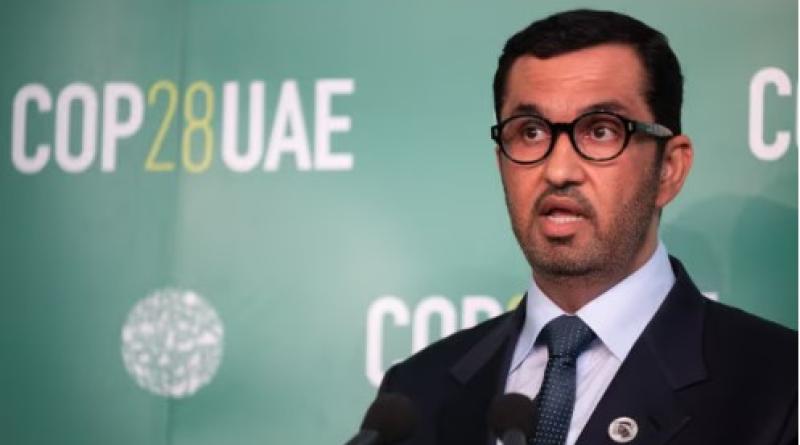What is Cop28 and why does it matter?

What is Cop28?
For almost three decades, world governments have met nearly every year to forge a global response to the climate emergency. Under the 1992 UN framework convention on climate change (UNFCCC), every country is treaty-bound to “avoid dangerous climate change” and find ways to reduce greenhouse gas emissions globally in an equitable way.
Cop stands for conference of the parties under the UNFCCC, and the annual meetings have swung between fractious and soporific, interspersed with moments of high drama and the occasional triumph (the Paris agreement in 2015) and disaster (Copenhagen in 2009). This year is the 28th iteration, and promises to be a difficult follow-up to last year, when developing countries celebrated victory on key issues of climate finance.
When does it start?
The conference will be hosted by the United Arab Emirates in Dubai, with the official start 30 November. World leaders will attend a segment known as the world climate action summit on 1 and 2 December, then leave their high-ranking officials to get on with the substance of the negotiations. The talks should close on 12 December, though experience of previous years suggests they could run on.
Why do we need a Cop – don’t we already have the Paris agreement?
Yes – under the landmark Paris agreement, signed in 2015, countries committed to holding global temperature rises to “well below” 2C above pre-industrial levels, while “pursuing efforts” to limit heating to 1.5C. Those goals are legally binding and enshrined in the treaty.
However, to meet those goals, countries also agreed on non-binding national targets to cut – or in the case of developing countries to curb the growth of – greenhouse gas emissions in the near term, by 2030 in most cases.
Those targets – known as nationally determined contributions (NDCs) – were inadequate to hold the world within the Paris temperature targets. If fulfilled, they would result in 3C or more of warming, which would be disastrous.
Everyone knew at Paris that the NDCs were inadequate, so the French built into the accord a “ratchet mechanism” by which countries would have to return to the table every five years with fresh commitments. Those five years ended on 31 December 2020, and at Cop26 in November 2021, countries assembled to set out new targets.
Didn’t all this get sorted out at Cop26?
The most important development at Cop26 was that countries agreed to focus on the tougher 1.5C aspirational goal of the Paris agreement, acknowledging that the 2C target would allow massive devastation to take place. Research conducted since the Paris agreement was signed has shown a temperature rise of 2C above pre-industrial levels would cause changes to the climate system that would be, in many cases, catastrophic, and some of them would be irreversible, so switching the focus to a 1.5C goal represents vital progress.
Many countries also updated their NDCs at Cop26, and countries responsible for about three-quarters of global greenhouse gas emissions set out long-term targets to reach net zero carbon by about mid-century.
However, to stay within 1.5C, the world must not only reach net zero by about 2050 but also halve greenhouse gas emissions, compared with 2010 levels, in this decade. However, the emissions pledges at Cop26 were not adequate to meet that goal.
So at the Glasgow summit, countries also agreed to hasten the ratchet mechanism, decreeing that progress on NDCs should be updated every year, and countries were encouraged to come forward this year, and as often as necessary, with new NDCs until they are adequate.
What has happened since?
No one at Glasgow could have foreseen what a changed world we would live in today. Vladimir Putin’s illegal invasion of Ukraine in February 2022 has sent shockwaves around the world. Geopolitics has been upended, alliances and relationships redrawn, and the world plunged into crisis.
Energy prices were already rising before Putin’s invasion, as the world recovered from the Covid-19 shock, but the Ukraine war sent gas prices soaring. Putin showed his willingness to use European dependence on Russian gas as a weapon of war, turning down the taps, threatening to withdraw supplies, then (almost certainly) sabotaging the Nord Stream pipeline.
The result was even higher gas prices and a bonanza for fossil fuel companies, which have been raking in record profits.
Faced with record-high gas prices, the EU took a series of steps that include an energy efficiency drive, a windfall tax on the excess profits of fossil fuel companies to try to lower household bills and a massive push for renewable energy.
But some EU countries also embarked on a hunt for new fossil fuel supplies, building liquefied natural gas terminals and seeking deals with countries in Africa and elsewhere to explore new gasfields.
The International Energy Agency warned in 2021 that no new fossil fuel development could take place if the world was to stay within 1.5C. If these developments are not swiftly curtailed they could be disastrous for hopes of avoiding the worst ravages of climate breakdown.
What happened at Cop27 last year?
Cop27 was held in Egypt, and marked a high point for developing countries seeking redress for the “loss and damage” that they are experiencing from the climate crisis. Loss and damage refers to the most severe impacts of climate-driven extremes of weather, such as the devastating floods in Pakistan last year or the drought in the horn of Africa.
Loss and damage has long been a vexed issue at Cops, but last year was a breakthrough. Developed countries at last agreed that a fund could be set up to disburse cash to the poorest and most vulnerable countries when they are stricken by climate disaster.
However, that agreement in Egypt was just the first step: at Cop28, countries must find ways to turn the fund from an idea to reality.
Isn’t the UAE an oil-producing country?
Yes, the UAE has some of the biggest proven reserves of oil and gas of any country in the world. Though the country has sought to diversify, into tourism, finance, sport and other areas, oil is still fundamental to its economy. Adnoc, the national oil company, is also planning a massive expansion of its production capacity.
More significant still, the man chosen by the UAE as president of Cop28 is the chief executive of Adnoc. Sultan Al Jaber is the first businessperson to serve as a Cop president, and being from an oil company is an extraordinary development.
Campaigners publicly – and some governments, privately – protested against his appointment, calling it a travesty. But Al Jaber did not back down, offering to meet NGOs around the world and listening to their objections. He views the role as a natural extension: without the involvement of fossil fuel companies, he argues, there can be no answer to the climate crisis.
Many people who have worked with Al Jaber report that he is sincere in wanting to find answers. Before taking on the Adnoc role, he was co-founder, in 2006, of the UAE government-backed renewable energy company Masdar, which now operates in many countries around the world, including the UK. He says he believes passionately in the transformation of the world’s energy systems, but a phasedown of fossil fuels can only happen when the spread of renewable energy has progressed.
What about the UK?
The host country of Cop26 has undergone a remarkable change of heart. Alok Sharma, the UK president of Cop26 under prime minister Boris Johnson, was promptly sacked from the cabinet by Rishi Sunak when he took the reins last autumn. Sharma attended Cop27 in Egypt, where he was visibly angered by some of the outcomes that he regarded as insufficient, but has played little role since.
Instead, the UK has seemed keen to erase the legacy of Cop26. The post of climate envoy within the Foreign, Commonwealth and Development Office was abolished, and the climate team for Cop26 dispersed, and though Sunak boasts that the UK is a “climate leader” with “world-beating” achievements, this is little in evidence.
Most of the emissions cuts he boasts of took place under previous governments, and in September the prime minister made a series of high-profile U-turns on net zero policy, including postponing the phaseout of petrol and diesel cars. These reversals were judged by the Climate Change Committee to have put the UK further from meeting its legally binding target of reaching net zero greenhouse gas emissions by 2050.
Worse, Sunak vowed to “max out” the North Sea and embarked on a major round of new licences. He is also planning new rules that would require fresh auctions of licences every year.
Sunak snubbed the UN general assembly this year, conveniently missing a climate meeting with the UN secretary general that his poor record would probably have denied him an invitation to. He will attend Cop28, and he will this year allow King Charles III to attend too and make a keynote speech – an engagement the monarch was denied last year, despite his global renown as a green champion.
Are we nearly there on 1.5C at least?
Only in the sense that record temperatures this year have taken us closer to 1.5C above pre-industrial levels than at any time in probably the last 100,000 years at least.
Temperatures in the world’s oceans reached levels described by one scientist as “gobsmackingly bananas”, and around the world records tumbled. Average temperatures for the year are still likely to be slightly below the 1.5C threshold, but the El Niño weather system is having a major impact.
One year, or even two or three years, of temperatures above the 1.5C limit would not mark a breach of the Paris agreement, as scientists would want to see a longer trend before pronouncing that the limit was passed.
However, if 1.5C is to be kept alive, much steeper cuts in emissions than any countries are yet planning will be needed, and soon.
Why is 1.5C so important?
As part of the Paris agreement, the world’s leading authority on climate science – the Intergovernmental Panel on Climate Change (IPCC) – was charged with examining closely what a 1.5C temperature rise would mean for the planet. They found a vast difference between the damage done by 1.5C and 2C of heating, and concluded that the lower temperature was much safer.
An increase of 1.5C would still result in a rising sea levels, the bleaching of coral reefs and an increase in heatwaves, droughts, floods, fiercer storms and other forms of extreme weather – but these would be far less than the extremes associated with a rise of 2C.
Further findings from the latest IPCC reports, published since Cop26, have underlined these warnings and concluded that there was still a slim chance for the world to stay within the 1.5C threshold but it would require concerted efforts. Crucially, they also found that every fraction of a degree of increase is important.
How far do we have to go?
Temperatures around the world are already at about 1.1-1.2C above pre-industrial levels, and greenhouse gas emissions are still rising.
Carbon dioxide output plunged during the Covid-19 lockdowns but emissions rebounded as economies recovered. To stay within 1.5C, global emissions need to come down by about 7% a year for this decade. Yet they are still rising.
What about net zero?
To stay within 1.5C, we must stop emitting carbon dioxide and other greenhouse gases – from burning fossil fuels, and from agriculture and animal husbandry, which create methane, from cutting down trees and from certain industrial processes – almost completely by mid-century. Any residual emissions remaining by then, for instance from processes that cannot be modified, must be offset by increasing the world’s carbon sinks, such as forests, peatlands and wetlands, which act as vast carbon stores. That balance is known as net zero.
Long-term goals are not enough, however. The climate responds to cumulative emissions, and carbon dioxide stays in the atmosphere for about a century after it is released, so we could reach net zero by 2050 but still have emitted so much in the meantime that we exceed the 1.5C threshold irrevocably.
That is why scientists are calling the 2020s the crucial decade for the climate: if emissions can peak soon and be reduced rapidly, we can keep cumulative emissions from growing too much, and still have a chance of staying within 1.5C.
Is Cop28 just about 1.5C?
The NDCs are a central part of the negotiations because of the global stocktake, a comprehensive assessment of global progress on the greenhouse gas emissions cuts needed to meet the goals of the Paris agreement.
However, climate finance will also be a key issue. This is an issue of vital importance to developing countries.
Climate finance is the money provided to poor countries, from public and private sources, to help them cut emissions and cope with the impacts of extreme weather. They were promised at the Copenhagen Cop in 2009 they would receive $100bn (£79bn) a year by 2020.
That target was missed, but preliminary data from the OECD this month shows that it was probably met last year, and almost certainly will be met this year (though some developing countries are unhappy at the way the data has been presented). This is an important milestone, but leaves many issues unresolved.
For instance, there are also problems with how climate finance is allocated: most of the money that flows currently goes to middle-income countries for projects that reduce emissions, such as wind or solar energy. Far less goes to the poorest countries, and only a fraction of the money goes to helping countries adapt to the inevitable impacts of the climate crisis.
At Cop26, developed countries agreed to double the amount of climate finance devoted to adaptation. Poor countries are still unhappy and will want to see significant progress on that at Cop28, and more finance provided in the form of grants rather than loans that can push countries further into debt.
One bright spot of climate finance is the vexed issue of loss and damage. This refers to the most devastating ravages of extreme weather, so great that no amount of adaptation can help with them. Examples include hurricanes and typhoons, the devastating floods that hit Pakistan this summer, or the droughts afflicting swathes of Africa. Recovery from such devastation can take years, if it is ever achieved, and the infrastructure of developing countries, services such as health and education, and their chances of improving the lot of their people, can suffer permanent damage.
The world’s poorest countries, which have done least to cause the climate crisis, are most at risk. In the past, some experts characterised loss and damage as a form of compensation or reparations for poor countries from the rich. However, this was unacceptable to developed and large developing countries, which refused to sign legal agreements potentially leaving them liable for unlimited future costs. So the discussion has moved on to loss and damage as a form of rescue and rehabilitation for the countries suffering most, differing from climate finance in that it does not apply to emissions cuts and addresses broader social and development issues as well as the immediate impacts of extreme weather.
For years, little progress was made but at Cop27 last year, in Sharm El Sheikh, countries agreed to set up a new fund for loss and damage. This was hailed as a breakthrough, but when talks on what such a fund would look like began in March this year, squabbles quickly took over. Four further meetings were required before a compromise was reached a few weeks ago, by which the fund will be administered temporarily by the World Bank, disbursed to the poorest and most vulnerable countries, and governments that are still classed as developing but which have large economies or oil wealth, such as China and the Gulf states, could be encouraged to pay into it.
The next difficulty is filling the fund. There is no agreement on how to do that, and developed countries have been slow in coming forward with new cash. Most countries accept that the fund will not be filled from governments alone: new sources of finance will be needed, which could include windfall taxes on oil and gas profits, levies on frequent flyers and on shipping, and the proceeds from the sale of carefully regulated carbon credits.
What about China?
The world’s biggest emitter, China, produced its NDC days before the start of Cop26 but analysts said it was disappointing. China will aim for emissions to peak by 2030, and reach net zero by 2060, and reduce the amount of carbon it produces per unit of GDP by 65%.
In early November this year, the US and Chinese climate envoys, John Kerry and Xie Zhenhua, met at Sunnylands in California for talks, producing a joint declaration in which China agreed to address non-CO2 gases, such as methane, in its NDC for the first time. This is progress, but other countries will want to see more action.
Encouraging signs come from recent analysis that suggests the massive surge in renewable energy generation in China could bring the country closer to a turning point. If that happens, global emissions could peak as soon as next year. But that is still a very big if.
This is the 28th Cop – why has all this taken so long?
Since the industrial revolution, the modern world has run on fossil fuels. We live in a Promethean age – nearly all of our prosperity and technology has been built on cheap, easy-to-access energy from fossil fuels. Ending their reign will require huge changes, to energy systems, to the built environment, to transport, to our behaviour and diet.
Getting everyone to agree on something so complex has not been easy. Developed countries have been unwilling to take on the costs, while developing countries have demanded the right to continue to use fossil fuels to achieve economic growth. There have been wranglings over historical responsibility, over burden-sharing, over costs, over science, and the politics has been influenced by changes of government in key countries – Donald Trump, for instance, withdrew the US from the Paris agreement.
On the plus side, the cost of renewable energy and other green technology has plunged in recent years, so that it is cheaper than fossil fuels in most parts of the world. Electric vehicle technology also progressed rapidly, and new fuels such as hydrogen are being developed. Cop28 is being held in a major oil and gas-producing country in the world’s key oil and gas-producing region. These are the countries that hold our future in their hands.
Benjamin Westhoff/EPA






